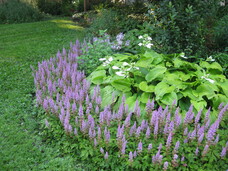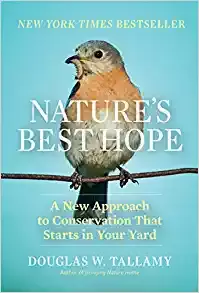AuthorLyn Chimera is a Master Gardener, consultant and lecturer. Archives
May 2023
Categories |
Back to Blog
June 2023 Tips6/3/2023
*|MC_PREVIEW_TEXT|*
0 Comments
Read More
Back to Blog
May 2023 Tips5/4/2023
*|MC_PREVIEW_TEXT|*
Back to Blog
Annual Plant Sale 20235/4/2023
Lessons from Nature and Amanda’s Native Garden and Perennial Plant Sale.
Saturday, May 20th, 9:00 – 2:00. 170 Pine St., E Aurora, corner of Pine & Lawrence. Clients and those of you who get my tips can come at 8:00 and beat the rush. We will have a larger variety of native plants on that one day than anywhere in WNY. All plants are dug fresh from my garden and those from Amanda’s Native Garden are started from seed by Ellen Folts, the owner. Check out her website for availability. Ellen will take orders and deliver them the day of the sale. I will also have a selection of hypertufa containers, draped concrete planters and birdbaths. I’ve been busily potting up when the weather has permitted. This is looking to be a bumper year for the plant sale. A list of available plants will be emailed the week before the sale. Note: all my plants will be root washed and potted in soilless potting mix due to the threat of the Asian jumping worm. If you’re not aware of this threat, you can get information at: http://ulster.cce.cornell.edu/environment/invasive-pests/jumping-worm
*|MC_PREVIEW_TEXT|*
Back to Blog
April '23 Tips4/1/2023
*|MC_PREVIEW_TEXT|*
Back to Blog
Ground Cover Beyond Pachysandra3/4/2023  By: Lyn Chimera Plants to cover bare soil have long been a staple of any garden. Basically, any plant that covers the ground can be used as groundcover. It doesn’t have to be low growing. Groundcover provides all sorts of benefits to a garden including less weeding, protection from soil erosion, reduction of water evaporation, softening edges, and protection of perennials from harsh winter temperature fluctuations. In addition to these benefits, ground cover is also good for the environment. By replacing some lawn with ground cover, you greatly reduce watering needs and use of herbicides along while creating a better habitat for beneficial insects. Ground covers also act as a living mulch to improve soil. Ground covers can be a beautiful addition to any garden by adding interest, texture, and beauty. Pachysandra, myrtle, and ivy are the most common ground covers in our area but there are so many other options. The following are some suggestions for a variety of growing conditions. They are all deer resistant. Bugle weed (Ajuga) is a fast spreading, low growing plant for sun to shade that has a lovely purple to lavender upright bloom in the spring. It comes in a variety of foliage colors from “chocolate” to variegated. Ajuga is a good choice for an area all its own. It is an aggressive spreader once established and not a good choice for between other perennials. It also works well in blooming or bee lawns. Wild Ginger (Asarum canadense) is an outstanding shade native for hard to grow sites. It forms dense cover with somewhat large attractive heart shaped leaves about 8-10 inches high. I have a wonderful patch under a giant Norway spruce where absolutely nothing else would grow. Better used around a tree than interspersed with other pants. Spreads well when established and would overtake a perennial bed. Astilbe is a shade loving flowering plant that comes in a variety of sizes and color of bloom. Astilbe chinensis, has low growing foliage, 6 – 8 inches, with a spike of lavender bloom in late summer when not much is blooming. It makes a great dense ground cover for the front of a border. Also makes a good lawn replacement plant. Taller varieties are good ground cover for mid to back of a bed. (see photo) Gold Star (Chrysogonum virginianum) is an excellent native ground cover for sun to shade. It has deep green textured leaves with lovely yellow blooms in spring with a smaller rebloom in late summer. The whole plant stays low even in bloom. An aggressive grower that will quickly cover an area. Japanese Painted Fern (Athyrium niponicum) makes a lovely color and texture addition to any shade garden. It is lower growing than many ferns (about 12-16 inches) and has graceful arched fronds as opposed to the upright fronds on many ferns. The Japanese painted fern comes in a variety of color combinations including silver, burgundy and cream. It is not aggressive so can be used among other shade perennials. Prefers moist soil. Bishop’s hat (Epimedium) comes in a variety of sized from 6 - 18 inches tall. The various varieties come in many colors including, white, pink, rose and yellow. It’s a perfect plant for dry shade. Epimedium blooms in spring before the leaves come up. The leaves are heart shaped, some with burgundy edges that turn all burgundy in the fall and persist during winter. Not an aggressive spreader. Moss There are many varieties of moss that do well in moist, acidic shade. Once established it is a beautiful ground cover. It does need moisture so would need to be irrigated during dry periods. Many people try to remove moss growing in their yards. It’s nature’s way of telling you that’s what wants to grow there so relax and enjoy it! Moss gardening is one of the newest trends in Horticulture. Lungwort (Pulmonaria) is a lovely spring blooming perennial that comes in a variety of bloom colors. The mottled leaves add great visual interest. It grows well in shaded areas and is not aggressive so won’t take over. Dwarf comfrey (Symphytum grandiflorum) is a real work horse. It’s low growing deep green leaves cover ground quickly. It will do well in part sun or shade and has lovely bell like blossoms in spring. It will even bloom in dense shade under a maple but not as vigorously as when it gets a little more sun. This plant is slow to establish but spreads well once it does. The plants above are just a sampling of the possibilities. With any plant you are considering, make sure it matches your growing conditions and check on its rate of spread. Many ground covers can be very aggressive which is desirable under certain conditions but not others. Master Gardener Education Day:Saturday, March 11 Classics V Banquet Center Niagara Falls Blvd. Three Excellent speakers: Tim Boebel, Gardening with Flowering Shrubs in the North Tim has published two books on hydrangeas--Hydrangeas in the North (2011) and Today’s Hydrangeas (2019). Paul Zammit, Container Gardening: Drama for Every Season A professor at Niagara College in Ontario and past Director of Horticulture at the Toronto Botanical Gardens. Allison Morrill Chatrchyan: How Climate Change is Affecting Our Gardening Allison is Senior Research Associate in the Department of Earth & Atmospheric Services in the College of Agriculture and Life Sciences at Cornell University. Time: 8:30 – 3:00 Cost $60 includes Continental breakfast, hot buffet lunch and basket raffle To register go to: erie.cce.cornell.edu/events or call 716-652-5400 ext. 176
Back to Blog
March '23 Tips3/1/2023
*|MC_PREVIEW_TEXT|*
Back to Blog
February '23 Tips2/1/2023
*|MC_PREVIEW_TEXT|*
Back to Blog
January '23 Tips1/1/2023
*|MC_PREVIEW_TEXT|*
Back to Blog
December '22 Tips12/1/2022
*|MC_PREVIEW_TEXT|*
Back to Blog
Give the Gift of a Book12/1/2022  By: Lyn Chimera Many of us are trying to decide what to buy for friends and family over the holidays. A book is always appreciated and often something people don’t buy for themselves. On the subject of gardening there are books on any topic you can imagine from trees to improving soil and everything in between. The following are some recommendations. The Living Landscape, by Doug Tallamy and Rick Darke is subtitled Designing for Beauty and Biodiversity in the Home Garden. Gardeners who want a landscape that supports nature and is beautiful at the same time will love this book. By combining the insights of two outstanding authors, this book offers a model that anyone can follow. The book outlines the strategies for making and maintaining a diverse, layered landscape from ground level to trees. The book includes providing for outdoor rooms, areas for children and pets, incorporates fragrance and edible plants all while providing cover, shelter and sustenance for wildlife. On top of all the excellent information the book is filled with beautiful photographs by Rick Dark who has won awards for his photography. This can be a coffee table book as well as an informational one. One of the most useful sections is at the end where they list plants by region showing growing needs and what they help in nature. Doug Tallamy had changed the conversation about the importance of home landscaping in supporting pollinators, birds and the plants and insects they need to survive. His book Bringing Nature Home is a must read as it describes the relationship between what you plant and how it matters to nature. It also includes an extensive section showing which plants support butterflies and moths as well as a regional listing of natives that have a benefit for wildlife. His second book Nature’s Best Hope covers a new approach to conservation that begins in our yards. He calls it “Homegrown National Parks”. His message is you don’t have to plant all natives but if everyone planted some the overall effect would be so beneficial to nature, beneficial insects and birds. The decline in honeybees has been in the news for years. The book Honeybee Democracy, by Thomas Seeley will give you an insightful look at the complex life of honeybees. Based on scientific studies, Seeley has written a very good and readable book about how bees operate and function as a group. We have a lot to learn from their “democratic” methods of decision making. You will never look at honeybees in the same way again. If you’re looking for a general how to book on gardening, The Well-Tended Perennial Garden, by Tracy DiSabato-Aust is excellent. This is one of the most useful and practical books for gardeners at all levels. There are chapters on basic perennial garden planning and maintenance, pruning and an encyclopedia of perennials that includes information on how to grow and maintain each plant. The appendix includes a perennial maintenance manual and listings of month-by-month maintenance suggestions. This book also includes lots of time and work saving techniques. It’s a go to book for basic and advanced perennial gardeners. If a book that gives detailed information on selected plants is what you’re looking for, Spring Wildflowers of the North East and Summer Wildflowers of the North East, by Carol Gracie would be perfect. In addition to the most amazing photographs these books educate the reader about each plant, its history, uses, propagation and growing conditions along with interesting facts. There aren’t just a few paragraphs about each plant but multiple pages. Even advanced gardeners will learn from these books. Anyone interested in trees would enjoy Finding the Mother Tree, Discovering the Wisdom of the Forest, by Suzanne Simard. This book is basically a story about her journey into the life of trees and coming to understand how they function. Simard brings us to the intimate world of trees, in which she brilliantly shows us that trees are not simply the source or timber or pulp but are a complicated circle of life. Trees in a healthy forest support each other and even communicate through underground networks. It’s fascinating and reads like a novel. There are so many books available about gardening and nature that you’re sure to find just the right gift – for yourself or others. |

 RSS Feed
RSS Feed


